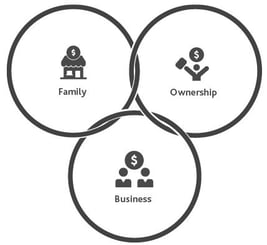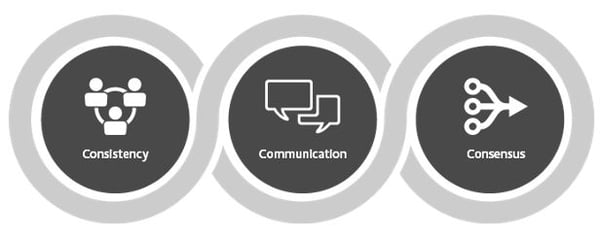Paving the Way for Continued Prosperity
Proficient chess players begin each game with a clear strategy that prepares multiple moves in advance. While each move is designed to set up the next, a strategic chess player will remain adaptable to changing circumstances. This same approach of strategic forethought, flexibility and responsiveness are best practices for succession planning in wealthy families as well.
Transitioning Leadership and Management
Succession will happen—it’s a matter of when, not if—so families should prioritize proactive planning to ensure a smooth, successful transition. Data highlights the consequences of inadequate succession planning: Although more than 30% of family-owned businesses transition successfully to the second generation, just 12% of those businesses are viable for the third generation, and a mere 3% are operating by the fourth generation, according to Family Business Review.
There are many aspects to robust succession planning, which, when done well, can help align decision-making and strengthen family unity. The succession plan should address transitioning both the ownership and control of the family wealth enterprise as well as the leadership and management of the family office and, if applicable, the business too. We addressed ownership and control concerns in our previous insight, How to Plan for Succession: Preserving, Protecting and Passing on Wealth, and here we focus on the equally important elements of leadership and management succession.
There are several key factors when transitioning leadership and management, and while the required skill sets will vary depending on the specific roles, the necessary considerations are similar. Diligent and nimble succession planning helps pave the way for continued prosperity in the family wealth enterprise. We’ve identified three different scenarios that encompass most transitions, but the decision-making about succession varies in significant ways across those scenarios.
Central Considerations for Leadership and Management Roles
 The family wealth enterprise has three interconnected circles of participation—the family members, the family’s business and the ownership of wealth—and each circle has a distinct lifecycle, but these lifecycles may not always correspond. That’s why having a detailed succession plan is so critical.
The family wealth enterprise has three interconnected circles of participation—the family members, the family’s business and the ownership of wealth—and each circle has a distinct lifecycle, but these lifecycles may not always correspond. That’s why having a detailed succession plan is so critical.
There are several key factors to consider when transitioning leadership and management, and while the required skill sets will vary depending on specific roles, the necessary considerations are similar. For example, when planning for succession, the person taking on ownership and leadership roles may be the same individual, but oftentimes they are not. Overall, the plan must outline how to assess a candidate’s characteristics in two main areas: interpersonal skills and professional experience.
People Considerations
Whether someone is a family member or not, assuming a leadership role will require the same traits, such as humility, accountability, maturity, integrity and diligence. The candidates for management or executive positions should possess these characteristics, even if they do not have an ownership role or voting control. A wide range of leadership positions may need to be filled, so the succession plan cannot focus on a single heir. For example, a management role in the family office will require a different skill set than someone on the management team of the family business. Thorough succession planning will account for each leadership opportunity and outline the specific preparations necessary.
Each role that transitions should have a detailed job description that defines the core functions and responsibilities. This description should also draw on input from people in that role, which can help to identify the required traits and characterize the ideal candidate. A frank evaluation of all candidates’ capabilities will help to assess and address any gaps. There are even certain tools to measure a person’s innate, instinctive strengths, such as the Kolbe A Index. Ongoing evaluations of the candidate can help keep the transition on track, and these evaluations can also be tied to compensation and reported to the board for approval.
A leadership role in the family office requires an understanding of the family’s history and values, as well as a thorough knowledge of any applicable investments. The successor will need to have a clear grasp on the family’s risk tolerance and its long-term, multi-generational goals. Crucially, this role also calls for the emotional quotient to manage personalities and balance competing interests within the family.
Professional Considerations
For leadership in the family business, the successor needs to have a comprehensive understanding of the business’s products and/or services and be able to persuasively advocate for the organization. They should also have deep-rooted industry knowledge and experience, which will help them tap the best people to fill roles throughout the business. They will need to combine this knowledge and experience with strong business acumen and the ability to manage people, so they can form and articulate a vision for the future that gains firm-wide buy-in.
There are important interfaces between the family office, family business and the family itself, as applicable. So, it’s essential to have clear controls, boundaries and communication protocols in place. The family should bear in mind the three C’s that form the pillars of effective governance: consensus, communication and consistency. Strong governance practices help facilitate information sharing as appropriate to achieve alignment and maintain unity.
Proactive succession planning can help energize family members and encourage their involvement in the family office and business activities. This deliberate planning can also increase the confidence of non-family executives and management by reassuring them about the stability and future prospects for the business. However, if succession planning is inconsistent or inadequate, that can diminish confidence and can have adverse effects, especially if an unqualified leader is chosen.
Effective succession planning is invaluable, but it can only be accomplished by making thorough preparations and outlining specific steps and key tasks, along with a clear transition timeline. Tying the plan to critical objectives and evaluating the progress and effectiveness of the transition on a recurring basis will help the family business stay on track for continued prosperity.
The Role of Non-family Leadership in the Succession Plan
Even if a family retains full ownership and control of the family wealth enterprise, certain non-family individuals can play a critical role in succession planning. This can include experienced advisors who are involved in the family office, non-family leadership within the business and other outside experts. Any trusted person who has familiarity with the family and influence with key members can provide helpful input about developing and carrying out the succession plan. Gaining the perspective of someone outside the family can broaden perspective and lend valuable insight to inform consequential decisions.
Three Scenarios for the Succession of Leadership and Management
Families should always be looking to identify and deliberately prepare successors for leadership and management roles among the rising generations. This is a core practice for effective family office governance and risk management. It’s also important to have a contingency plan in case of the unexpected, such as if the designated heir is unable to fill the role for any reason.
There are three main scenarios for how the succession of leadership and management proceeds, and each one raises distinct questions that must be addressed:
- A family member has been identified to take over, and they’ve had thorough preparation along with participation in the family office or business. How can you best set them up for success in terms of planning and communication around the transition?
- A family member has been identified to take over, but they might be too young or don’t have the skills yet. How can you vet them to determine readiness, and what do you do in the interim?
- No family member wants to take over, no one is prepared or no one is qualified. What is the process to pick a non-family successor or determine the future of the business?
Scenario #1: Facilitating Success for the Chosen Heir
This is the most straightforward scenario: Deliberate succession planning has proceeded as envisioned, and the timing is appropriate. The identified heir should have already gained the requisite education and experience in terms of finances, business acumen, leadership and decision-making. This preparation and training will have positioned them to fulfill the key duties for a leadership role.
While these conditions are ideal, steps still must be taken to put the heir in the best position possible upon takeover. It’s critical to communicate the succession plan to all key stakeholders on an appropriate timeline, which helps to bolster confidence in the family’s plan and maintain continuity during the transition. Compensation is an important element to review, and it should be commensurate with the heir’s skills, experience and performance relative to similar roles at other organizations.
It’s also important to establish a new role for members of the older generation who are handing over control. One option is to form an advisory board that includes members of the older generation—as well as others, potentially closer in age to the heir’s peer group—for major decisions or to help guide the new leader until they mature in their position.
Scenario #2: The Heir Isn’t Ready and an Interim Plan Is Needed
Timing is a critical variable in any succession, and the lifecycle of the family office or business may not line up completely with plans for the chosen heir. In these cases, a non-family individual may be necessary to fill a leadership role on an interim basis. This could be a good opportunity for an experienced person near the end of their career or for someone who is already part of the business but seeking a temporary role.
When placing a non-family individual in a leadership role, it’s especially important to have a mutual understanding of the family’s interests, goals and the expected timeline, which will help maintain alignment and avoid potentially damaging miscommunications. Critically, this non-family member should also be prepared to mentor the chosen heir and facilitate their future transition into the role.
Compensation for a non-family member in their interim role can be a complex consideration, and most family-owned businesses will not want to surrender equity. Although an ownership stake can help link incentives to business performance, there are other options to achieve this. For example, a phantom stock agreement can tie compensation to business outcomes without giving up equity. In any scenario, compensation should be reviewed closely and be subject to board approval.
It’s also not strictly necessary to find an outside candidate, and, in certain cases, the senior family member may simply maintain their role for longer than initially planned. Then they can transition the selected heir into the role when ready without bringing in a non-family individual to a leadership position. If this occurs, the senior family member still must accept that they will eventually need to give up control. An updated timeline should account for that, and new contingency plans should be made to remain adaptable. This process of deciding when to transition leadership to the rising generation can be similar to creating a will and organizing for the next phase; it’s often put off for a later date, but it’s beneficial to be proactive.
This scenario can also be a trigger to sell the business, depending on the unique circumstances of the business and family. The timeline and assessment of the chosen heir’s readiness for the role may be a determining factor. Ultimately, dutiful succession planning in advance should have specifically outlined the leadership traits, professional experience and business acumen needed for the role, along with methods for assessment. These criteria will help evaluate the options and inform the decision-making.
Scenario #3: There Is No Heir and the Family Must Decide About the Future
Sometimes, for a variety of reasons, there is no heir identified or available to fill the role. Then it may be necessary to select a non-family individual as a successor for long-term leadership and management. If so, the family will still want to retain ownership and control while also ensuring continuity for ongoing success.
In this case, the process will be similar to identifying an executive candidate in a business. It requires a clear description of the role and a defined set of expectations for the candidate to fulfill, but it’s imperative for them to establish trust and confidence with the family and key stakeholders in the business. Clearly outlining their responsibilities, and confirming the experience and ability to carry them out, will prepare both the family and the candidate for success.
However, lacking an identified heir can trigger difficult decisions about the future of a family business. Selling the business or going public could be viable options, depending on the family’s goals and circumstances, as well as the overall outlook for the business and industry. In some cases, ceding control may be the best way for family members to “cash out” and maximize value, but there are many options available, including tapping current non-family executives.
Bringing in non-public investors who can provide both capital and expertise can also help continue business operations, and their compensation can be structured in a way that avoids giving up equity and maintains full ownership. Particularly in this scenario, it’s important to link compensation to business performance without yielding equity, and a phantom stock agreement is one way to achieve this. Ultimately, there is no single solution for this scenario, but deliberation among all key stakeholders will help to weigh the options and decide upon the best course to address the family’s goals and values.
Leadership Compensation Considerations
- Family Member: Compensation should be commensurate with the heir’s skills, experience and performance relative to similar roles at other organizations.
- Non-Family Individual: Compensation should be reviewed closely and subject to board approval.
- Non-public Investors: Compensation can be structured to avoid giving up equity and maintain full ownership
Scenario Planning for Your Family
While the appropriate strategy for succession planning will depend on the individual situation, every plan and timescale must remain adaptable to changing circumstances. Building flexibility into the plan is critical to navigating unplanned external triggers, like an economic downturn, which may require reassessing the succession plan. A range of other disruptors can impact the plan, including industry-specific changes, new regulations, demographic shifts, technological advancements or even a public health crisis. Families may have to deal with unforeseen personal issues that arise too (e.g., divorce, health complications, death), so succession planning should have ample forethought along with recurring assessments. Even with the best-laid plans, remaining responsive and adaptive is invaluable.
The succession of leadership and management requires a long-term strategy, so families should think far beyond the next move. By preparing well in advance, identifying clear requirements for each role, providing ample training for necessary capabilities and remaining adaptable to shifting circumstances, families can protect their legacy and ensure ongoing success.
3 Steps for Leadership and Management Succession:
- Set a clear and flexible strategy for transitioning leadership and management roles.
- Have a contingency plan in place should circumstances change.
- Outline directives for family and non-family successors, including personality traits, business acumen, responsibilities and compensation.





